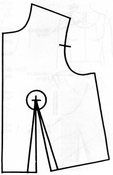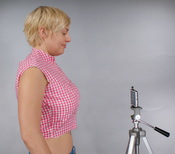|
How to Make Sewing Patterns, 2nd Edition
by Don McCunn
New in the Second Edition
It has been 39 years since the first edition of How to Make Sewing Patterns became available. During that time I have developed new and different ways of doing things. Many of these new ideas have come from my students as they learn how to create custom-fit patterns. Some of the techniques that are now possilbe are because of the way our world has changed. Here is a summary of what is new in this second edition.
Don McCunn
Contents
| Woman's Front Bodice Sloper
|
The second edition of How to Make Sewing Patterns takes a new approach to creating the woman's front Bodice Sloper. This Sloper shapes the fabric for two contours: Above the Bust and Below the Bust. In the first edition, the shaping for the Sloper was done with a single dart shaped to the waist.
In this new edition, the shaping for the two contours is done with two darts: one above the bust and another below the bust. This is a more efficient and accurate way to create this Sloper.
|

Sloper in 1st Edition |
|

Bust Contours |
|

Sloper in 2nd Edition |
| Gingham for Fittings
|
 |
|
Gingham is a perfect fabric for fitting Slopers as it allows you to verify that the grain of the fabric is following the lines of the body such as Center Front, Center Back and the full bust level. The vertical grain at locations such Side Front and Side Back will verify that darts are shaped correctly.
By using gingham that has a pattern in 1/4" squares, it is possible to refine a fitting within an 1/8".
|
| Photos for Fittings
|
 |
|
Photographs of gingham fitting shells can be used for highly accurate fittings. You can fit Slopers on a person regardless of where they are located. Even friends and family who might live in a different part of the world.
By using a tripod and timed or remote shutter release these photos are perfect for do-it-yourself fittings.
|
| Optimizing the Pants Pattern for Tummies |
Tummies can easily change the way pants hang on the body. Instructions are included for how to adjust the Pants Sloper for a custom fit regardless of the size of the tummy. |
 |
|
 |
This shows a muslin fitting shell made from a Pants Sloper before the adjustment is made for the tummy.
|
|
This shows a pair of pants made for the same body using a Pants Sloper that has been adjusted.
|
| More on Knits
|
 |
|
The instructions in the book show how to create and fit Slopers for woven fabric. Woven fabric, like paper, can only bend in one direction at a time. In order for the fabric to match the three-dimensional contours of the body, the fabric needs to be shaped by either darts or seams. Furthermore most garments made from woven material need a closing device such as zippers or buttons.
Knit fabrics are different because they can assume a three dimensional shape. The Sloper patterns for woven fabric can be modified to accomondate this quality of knit fabric. Examples include how to create tops, raglan sleeves, leggings, and circular skirts that have no opening device. |
| Close Fitting Pants
|
 |
|
The instructions for the Pants Sloper are for a slacks cut that includes a leg hanging straight down from the torso. This loose leg is the best way to verify that the shaping of the torso portion and the crotch curve of the pants are correct for the body. Instructions are included in this new edition to show how that slacks cut can be modified to create close fitting pants and even leggings. |
|
 |
| Measurements and Scale Rulers in Inches and Centimeters
|
This edition of How to Make Sewing Patterns includes measurements in both inches and centimeters.
When you create Slopers you are working from circumference measurements for the full body, such as the bust and waist. But Slopers only need to be for half the front or half the back. This means the circumference measurements need to be divided by four. Scale Rulers eliminate the need for you to do the head math saving time and eliminating potential errors.
Instructions are included for how to make scale rulers in either inches or centimeters. In addition to drafting the Slopers, these Scale Rulers can be used for a variety of pattern design applications.
|

Draft Patterns |
|

Adjust Patterns |

Design Patterns |
|

Draft Circles |
| Quarter Scale Mini-Me Dress Forms
|
 |
|
A common recommendation for people learning pattern design is to try the various pattern making techniques using quarter scale patterns. This edition of the book takes the process further by suggesting that the resulting patterns can be made in fabric. This way you can both practise the techniques and view the final results.
Instructions are included on how to convert full size patterns to quarter scale patterns. When this is done with the Slopers, you can make a custom Mini-Me Dress Form. This allows you to see what full size garments are going to look like on the body they are intended for. This is an excellent way to prototype new designs.
|
|